The DXY Index is currently showing slight losses at 105.35, signaling a modest bearish trend. Market attention is focused on conservative comments from the Federal Reserve, as well as expectations for April inflation that could influence the outlook for the US Dollar. Despite this, bets on the Fed remain steady, providing some support for the USD.
The Federal Reserve has maintained a hawkish stance towards cutting interest rates, which has helped prevent significant losses for the US Dollar. The Fed’s cautious approach is data-driven, with key indicators such as the Consumer Price Index (CPI) and Retail Sales playing a crucial role in shaping the narrative. The probability of rate cuts in the near future has decreased, indicating a more hawkish outlook among investors.
This week is expected to bring three major economic figures – the Producer Price Index (PPI), CPI, and Retail Sales. Market predictions suggest a continuation of inflation and strong growth in the US, which could further support the Greenback’s rally. The upcoming data releases will be critical in determining the direction of the USD.
The technical picture of the DXY Index shows mixed signals, leaning towards a more bearish outlook. The Relative Strength Index (RSI) is indicating a negative slope, pointing to growing selling pressure. The Moving Average Convergence Divergence (MACD) is displaying flat red bars, suggesting a struggle between bullish and bearish momentum. The Index is currently trading below the 20-day SMA, indicating short-term bearish dominance.
Inflation measures the rise in the price of goods and services over time, with core inflation excluding volatile elements such as food and fuel. Central banks aim to keep core inflation around 2% to maintain a stable economy. Higher inflation typically leads to higher interest rates, which can strengthen a currency. Conversely, low inflation may weaken a currency as central banks lower interest rates to stimulate the economy.
Historically, gold has been seen as a safe-haven asset during times of high inflation. However, in today’s market, higher inflation could actually lead to lower gold prices. This is because central banks tend to raise interest rates in response to inflation, making gold less attractive as an investment compared to interest-bearing assets. Conversely, lower inflation tends to benefit gold prices, as it may lead to lower interest rates, making gold a more viable investment option.
Understanding the impact of inflation on the US Dollar is essential for investors and traders. By analyzing current market trends, the Federal Reserve’s stance on rate cuts, upcoming economic figures, technical indicators, and the relationship between inflation and currency value, individuals can make informed decisions in the ever-changing financial landscape.

